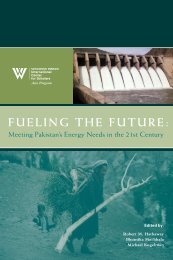Environmental Change and Security Project Report - Woodrow ...
Environmental Change and Security Project Report - Woodrow ...
Environmental Change and Security Project Report - Woodrow ...
You also want an ePaper? Increase the reach of your titles
YUMPU automatically turns print PDFs into web optimized ePapers that Google loves.
<strong>and</strong> deprivation. But what about the environment?<br />
If we take stock of the last dozen years,<br />
has the health of the planet improved, <strong>and</strong> what<br />
steps can we take to ensure that this development<br />
assistance is sustainable for the economy<br />
<strong>and</strong> the Earth?<br />
The Diagnosis<br />
The world’s population more than doubled<br />
from 1950 to 1998, <strong>and</strong> in the last 10 years it<br />
has increased by about 14 percent to reach a<br />
staggering 6.4 billion (United Nations<br />
Population Division, 2003). Optimistic projections<br />
peak in 2050 at 9 billion, an increase of<br />
50 percent despite notable strides in family<br />
planning <strong>and</strong> the uncertain effects of<br />
HIV/AIDS (Population Reference Bureau,<br />
2004). This unprecedented population growth<br />
has directly pressured l<strong>and</strong> resources by increasing<br />
<strong>and</strong> intensifying agricultural use of marginal<br />
l<strong>and</strong>, subjecting it to damaging overuse, such<br />
as excessive irrigation. Although 20th century<br />
inventions revolutionized agricultural productivity,<br />
831 million people across the world<br />
remain hungry <strong>and</strong> malnourished (United<br />
Nations Development Programme, 2004).<br />
During the first half of the 21st century, many<br />
areas of the globe are expected to suffer heavy<br />
losses of cropl<strong>and</strong> due to degradation, soil erosion,<br />
<strong>and</strong> climate change. About two billion<br />
hectares of soil—equal to 15 percent of the<br />
Earth’s l<strong>and</strong> cover—is already degraded (World<br />
Resources Institute [WRI], 2000). Between<br />
1984 <strong>and</strong> 1998, the world’s grain harvest fell<br />
behind population growth, with output dropping<br />
by 9 percent, or 0.7 percent yearly<br />
(Brown, Gardner, & Halweil, 1999). The prognosis<br />
is disheartening; there are so many more<br />
mouths to feed, but less to feed them.<br />
The Food <strong>and</strong> Agriculture Organization<br />
(2003) predicts that developing countries will be<br />
forced to steadily increase their food imports.<br />
Unable to meet rising dem<strong>and</strong>s for food, countries<br />
will suffer greater poverty, declining health,<br />
higher infant mortality, <strong>and</strong> increased migration.<br />
As agriculturalists encroach on pastoralists<br />
in Africa, l<strong>and</strong> use disputes can contribute to<br />
violent conflict. 3 So can migration, as in Chad,<br />
where incoming refugees competed with locals<br />
for scarce l<strong>and</strong> resources (United Nations High<br />
Commissioner for Refugees, 2004).<br />
Deforestation exacerbates the competition for<br />
livelihoods; forest cover has declined by 2.4 percent<br />
since 1990, despite our pledges at Rio to<br />
reverse this trend (WRI, 2000).<br />
Water stress is even more life-threatening than<br />
degraded l<strong>and</strong> resources. By the mid-1990s, 80<br />
countries, representing 40 percent of the world’s<br />
population, suffered serious water shortages<br />
(United Nations Environment Programme<br />
[UNEP], 2002). By 2025, two-thirds of the<br />
entire world could experience moderate to severe<br />
water stress (United Nations Department of<br />
Economic <strong>and</strong> Social Affairs, 2002). Eighteen<br />
percent, or 1.1 billion people, currently lack<br />
access to safe drinking water, <strong>and</strong> 2.4 billion do<br />
not have adequate sanitation, mostly in Africa<br />
<strong>and</strong> Asia. Unsafe drinking water <strong>and</strong> inadequate<br />
sanitation transmit deadly waterborne diseases<br />
like malaria (1.2 million deaths/year) <strong>and</strong> diarrhea<br />
(1.8 million deaths/year); 90 percent of the<br />
victims are children under five (World Health<br />
Organization, 2004).<br />
The news is not all bad, however: in the past<br />
decade, people with access to improved water<br />
supplies increased from 4.1 billion (79 percent)<br />
in 1990 to 4.9 billion (82 percent) in 2000,<br />
largely due to better national water policies,<br />
river basin cooperation, <strong>and</strong> more coordinated<br />
donor policies (UNEP, 2002). River basin<br />
cooperation may have also prevented conflict;<br />
scarce water resources can be a source of tension,<br />
but, as demonstrated by the Nile Basin<br />
Initiative, agreements to manage basins can<br />
improve relations. 4<br />
Unfortunately, the oceans are not improving.<br />
Pressure on the coastal zones constantly<br />
increases: more than 40 percent of the world’s<br />
population now lives within 100 kilometers of<br />
the coast (WRI, 2000). Twenty-eight percent of<br />
the world’s most important fisheries are depleted<br />
or overexploited, putting at risk the one billion<br />
people who rely on fish as their primary<br />
protein source. Overfishing by locals <strong>and</strong> by<br />
worldwide fleets “vacuuming the seas” can lead<br />
13<br />
COMMENTARY • THE NEXT STEPS FOR ENVIRONMENT, POPULATION, AND SECURITY

















